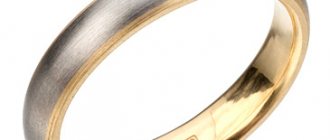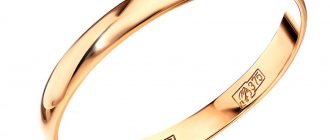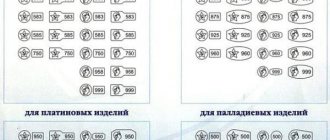The word ounce is translated from Latin as “trifle” or “little.” This term began to be used in Ancient Rome, when it denoted a measure of weight, namely the twelfth of an assa, a coin weighing 27.3 grams. Soon, throughout the entire European part of the world, they knew what an ounce of gold was and how much an ounce of gold weighed; it began to be used as a generally accepted measure of weight. Many countries, however, abandoned it in favor of the metric system. However, the ancient measure of gold in grams is still used today by jewelers and bankers. So what is 1 ounce of gold, a troy ounce, how many grams of gold is in it?
How many grams are in one ounce of gold
The Troy, also known as gold coin, pound weighed 373.2417 g (the same as 87.5 Russian zolotniks).
A troy ounce (1/12 pound) is equal to 31.1034768 g - this unwieldy number is often shortened to 31.1035, which is a joy to remember when trying to remember it.
One kilogram contains 32.1507 ozt of gold.
Investments in gold: profitable or not?
In 2005, Rick Munaritz, one of the co-owners of the Internet service, faced a dilemma: what is more reliable to invest his money in - the Google search engine or gold. At that time, their prices on the stock exchange were the same. But in 2008, the crisis struck and trading in Google closed at $307 per share, and in gold at $866 per ounce.
Cost per ounce
An ounce of gold is a sign of quality, its value is a symbol of purity. Its value is determined in US dollars. The metric system is more common, but it is still not widely used.
The price of gold is determined by the London fixing. It took place for the first time on September 12, 1919. It is conducted by the main players in precious metals trading, including the five leading banks in the world. The price is not constant, it is fixed twice a day, the first time at 10-30 London time.
Over the years, the value of precious metals has increased almost 2.5 times, and this is not the limit. Leading financiers foretell a protracted rise in the value of precious metals.
One modern measure of gold is equivalent to what it was two centuries earlier. For example, in the 18th century, a good men's suit was priced at an ounce. Now its cost remains the same. This confirms the benefits of investing savings in gold, reliably protecting them from depreciation.
General information
Mass is the property of physical bodies to resist acceleration. Mass, unlike weight, does not change depending on the environment and does not depend on the gravitational force of the planet on which this body is located. Mass m
determined using Newton's second law, according to the formula:
F
=
m a
, where
F
is force and
a
is acceleration.
Mass and weight
The word “weight” is often used in everyday life when people talk about mass. In physics, weight, in contrast to mass, is a force acting on a body due to the attraction between bodies and planets. Weight can also be calculated using Newton's second law: P
=
m g
, where
m
is the mass and
g
is the acceleration due to gravity. This acceleration occurs due to the gravitational force of the planet near which the body is located, and its magnitude also depends on this force. The acceleration of free fall on Earth is 9.80665 meters per second, and on the Moon it is approximately six times less - 1.63 meters per second. Thus, a body weighing one kilogram weighs 9.8 newtons on Earth and 1.63 newtons on the Moon.
Moon mass 7.3477×10²² kg
Gravitational mass
Gravitational mass shows what gravitational force acts on a body (passive mass) and with what gravitational force the body acts on other bodies (active mass). With an increase in active gravitational mass
body, its force of attraction also increases. It is this force that controls the movement and location of stars, planets and other astronomical objects in the universe. Tides are also caused by the gravitational forces of the Earth and Moon.
With increasing passive gravitational mass
the force with which the gravitational fields of other bodies act on this body also increases.
Inert mass
Inertial mass is the property of a body to resist movement. It is precisely because a body has mass that a certain force must be applied to move the body from its place or change the direction or speed of its movement. The greater the inertial mass, the greater the force required to achieve this. Mass in Newton's second law is precisely inertial mass. The gravitational and inertial masses are equal in magnitude.
Mass and relativity
According to the theory of relativity, gravitating mass changes the curvature of the space-time continuum. The greater the mass of a body, the stronger the curvature around this body, therefore, near bodies of large mass, such as stars, the trajectory of light rays is bent. This effect in astronomy is called gravitational lenses. On the contrary, far from large astronomical objects (massive stars or their clusters called galaxies), the movement of light rays is linear. The main postulate of the theory of relativity is the postulate about the finiteness of the speed of propagation of light. Several interesting consequences follow from this. Firstly, one can imagine the existence of objects with such a large mass that the second cosmic velocity of such a body will be equal to the speed of light, i.e. no information from this object will be able to reach the outside world. Such cosmic objects in the general theory of relativity are called “black holes” and their existence has been experimentally proven by scientists. Secondly, when an object moves at near-light speed, its inertial mass increases so much that local time inside the object slows down compared to time. measured by stationary clocks on Earth. This paradox is known as the “twin paradox”: one of them goes into space flight at near-light speed, the other remains on Earth. Upon returning from the flight twenty years later, it turns out that the twin astronaut is biologically younger than his brother!
Why are gold reserves needed?
The natural question is why are gold reserves so important? Why did this precious metal become the cornerstone in the emerging global economic system?
Firstly, the presence of significant gold reserves allows the state to maintain economic independence from other currencies. Secondly, gold is still one of the reliable investment options. Over the last decade alone, the value of this yellow metal has increased more than 5 times. In the event of an unstable economic situation in the domestic market of the state, threatening inflation of the national currency, gold will be able to serve as a kind of monetary equivalent recognized throughout the world.
Using recalculation in practice
The need to convert ounce to gram arises, in most cases, when trying to calculate how much gold or silver costs per gram in national currency, for example in rubles, today. The calculation algorithm is quite complex and requires knowledge not only of the cost of the metal in dollars per ounce, but also of the ruble/dollar exchange rate. It looks like this:
the cost of gold (USD/ozt) divided by 31.1035 and multiplied by the exchange rate USD/RUB, we get the price of gold in RUB/g.
There is a calculator for calculating the cost of gold, which makes calculations based on data from the Central Bank, which makes it much easier and faster to get the desired result.
You can find a large number of unit converters on the Internet; when using such programs to convert the weight of precious metals, it is important to remember that you need a troy ounce, and not some other unit.
How much is gold today?
The dynamics of changes in the price of gold are of great interest not only to those who have chosen it as an object of investment. This is a kind of indicator of the state of the world economy. So, let's analyze how the gold rate has changed in recent years. In 1996, one ounce of gold cost about $400; already in 2010-2011, the price per ounce of gold rose to $1,300. During this time interval the increase was almost 30%. According to analysts, 2015 was not so good for the precious metals market. The cost of one ounce fell from $1,000 in 2014 to $840 in 2015. And in 2016 there are quite convincing preconditions for an increase in the price of the yellow metal.
What else is measured in troy ounces besides gold?
The weight of precious metal coins issued by central banks is measured in fractions of a troy ounce. For example, in the United States, American Eagles have been minted since 1986 - an official means of payment recognized in the world precious metals market. The coins are available in four denominations: 1/10, 1/4, 1/2 and 1 ounce. Based on the Gold Weight Coin Act, the gold content of the coins is guaranteed by the US government. Thus, a gold coin weighing 1 ounce, i.e. 31.104 grams, weighs a total of 33.931 grams. It has a diameter of 32.70 millimeters and a thickness of 2.87 millimeters.
Most modern coins are produced from various alloys that contain one or another proportion of precious metal. In Russia, grams are usually used to indicate the weight of a coin, but the precious metal content always corresponds to a certain fraction of a troy ounce. Thus, the gold commemorative coin “St. George the Victorious” with a face value of 50 rubles, issued by the Bank of Russia, weighs 7.89 grams, the mass of pure gold in it is at least 7.78 grams, which is 1/4 troy ounce. And the silver “St. George the Victorious” with a face value of 3 rubles weighs 31.5 grams, the mass of pure silver in the coin is at least 31.1 grams, i.e. approximately one troy ounce.
Sources
- https://GoldInside.ru/poleznoe/ckolko-gramm-v-untsii-zolota.html
- https://VseoMetallah.ru/zoloto/skolko-gramm-v-trojskoj-untsii
- https://zhazhdazolota.ru/interesnoe/trojskaya-untsiya-v-grammah
- https://www.zolotoy-zapas.ru/why-gold-coins/chto-takoe-troyskaya-untsiya/
- https://FB.ru/article/151372/untsiya—eto-skolko-untsiya—skolko-gramm
- https://1Ku.ru/obrazovanie/66204-uncija-jeto-skolko-v-uncii-gramm-zhidkaja-uncija/
- https://GoldMiddle.ru/na-zametku/unciya-zolota-v-grammah.html
Measure in different countries
An ounce of gold is how many grams are understood, and what other units of weight are there, because not all countries followed the generally accepted unit of measurement.
- In Germany, it was equated to 16 parts of a trade pound or 8 parts of a mark, as well as 12 parts of a small pharmaceutical weight. By the way, this measure came to our pharmacies from Germany.
- In Italy it was equivalent to 12 parts of a pound.
- In Spain and Portugal it was 16th of the trade pound.
- An ounce in Sicily was a coin unit, namely 2.5 scudi and 3 ducats.
- In Spain it was a doubloon, as in Latin America.
- A shekel of Hebrew origin is equal to 11.4 grams, and a quarter of it is 2.9. Used extremely rarely.
- There is a tola in Luxembourg, it weighs 11.7 grams. It is used more often when selling scrap gold.
- In Taiwan, a bass of 15.2 grams is used.
- In Thailand, they focus on a tael, equivalent to 37.5 grams.
- Tael in China or Hong Kong is 37.4 grams.
Translation problems
Translation problems arise due to the presence of different names depending on the field of use and the country where it is used. Adding to the confusion is the fact that some countries, such as the United States, still do not use the metric system, preferring the traditional one.
- Avoirdupois (oz or oz at) – 28.35 g, used by the USA as a measure of weight.
- Fluid ounce (fl oz) – 29.573 531 ml, used to determine the volume of liquid.
- Troy ounce (toz or ozt) – 31.1034768 g, this value is used throughout the world to measure the weight of precious metals.
Why is there no single standard
An ounce is a unit that is measured in different ways. The explanation for this is as follows. It has been used historically in many parts of the world, at different points in history, and for different applications. Therefore, unequal mass standards were taken as a basis.
How much does an ounce weigh in different values? The international version of avoirdupois calls 28.349523125 437.5 grams. An international troy ounce is 31.1034768 480 grams, a French ounce is 30.59 grams. There are other numerical values. It is worth learning more about what types of this unit of measurement are used in the modern world.











